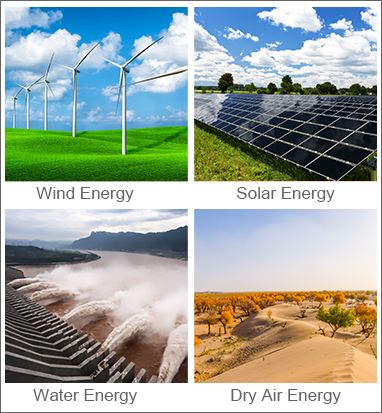Evaporative cooling technology

Dry air energy
※ Dry air energy refers to the amount of energy (cold) that unsaturated air tends to be saturated. It is expressed as the difference between the enthalpy value corresponding to the dry bulb temperature of dry air and the enthalpy value corresponding to the dew point temperature of dry air. The cooling capacity obtained at the time is a green and clean renewable energy source.
※ Vast area of northwest China are typical of dry and hot weather conditions, which contain abundant dry air energy. The rational use of dry air energy and other new energy sources for air conditioning and refrigeration to replace conventional energy sources has a very important reality for the sustainable development of the economy and society.
※ Evaporative cooling technology is an effective way for dry air to realize energy (cold) utilization in dry and hot areas.
Evaporative cooling phenomenon

When you walk along the beach, cool sea breeze brings you relaxed and happy; When you are at the edge of the waterfall, you will feel the magic of nature. The coolness and freshness are all water evaporation from nature. Water evaporation makes people feel cool and the air fresh.
Types of evaporative cooling
▶ Evaporative cooling technology is to use dry air energy to obtain the refrigeration capacity required by air conditioning. In different types of evaporative refrigeration devices, low-temperature cold water or cold air is obtained by heat and moisture exchange between water and dry air.
▶ According to whether water and air are in direct contact, evaporative cooling technology is divided into direct evaporative cooling and indirect evaporative cooling.
▶ According to the different cooling media, evaporative cooling technology equipment can be divided into evaporative air cooler and evaporative water cooler.
Working Principle of Direct Evaporative Cooling

▶ With water as the medium, let the water fully wet the "cooling pad" (corrugated fiber composite with high evaporation efficiency and high anti-corrosion performance, which is made of poplar and bonded through multiple processes). When the dry and hot air passes through the cooling pad, the water absorbs a large amount of heat in the air, and what flows out is wet and cool air, which is direct evaporation.
▶ The air that has been evaporated and cooled by the JHCOOL evaporative air cooler, sent into the room and forced to ventilate the room with positive pressure.
Application of evaporative cooling
▶ E Relatively dry and hot areas and almost all places that require cooling or ventilation can be used, such as shopping malls, supermarkets, offices, hotels, hospitals, stations, stadiums, exhibition halls, restaurants, dance halls, auditoriums, conference rooms, schools, Factory workshops, villas, etc.
▶ Areas with high relative humidity, and very suitable for industrial production workshops with high temperature or peculiar smell, such as textile factories, garment factories, printing and dyeing factories, etc., which can be used for local cooling or overall cooling. At the same time, it is also very suitable for places where the air is sultry and difficult to remove, such as: game halls, discos, hotel kitchens, laundry rooms, etc., and can be used as cooling and ventilation equipment.
▶ Traditional air-conditioner has been installed, but the air circulation is poor and the indoor air is turbid and relatively dry;
▶ It can be applied to the energy-saving transformation of communication base stations and cooling equipment in computer rooms or IDC.
Advantages of evaporative air cooler
- 70% less electricity than traditional air conditioner
- 100% fresh air
- Dust filtration up to 80%.
- No freon, environmental protection.
- Opening door/window does not affect the cooling effect .
- The initial investment is only half of the central air-conditioner.
Quick checklist for cooling of evaporative air cooler

Working principle of evaporative water cooler

Evaporative water cooler is the external unit of evaporative air conditioner. The thermal conductivity of water is higher than that of air, and water will take away a large amount of latent heat energy in the process of vaporization. Based on this principle, the heat generated when the compressor works will be directly released into the water, the water temperature will rise, the high-temperature water will be drenched into the cooling pad, and the heat will be taken away by evaporation to reduce the water temperature, Then return the cold water to the condenser to cool it. Cooling the air conditioning condenser by this evaporative cooling technology is the working principle of evaporative air conditioner.
Advantages of evaporative water cooler
Enegy saving
Traditional air conditioners use air cooling to cool the condenser. Due to the temperature conditions and installation location, the compressor often works unstable and sometimes even stops working, which greatly reduces the service efficiency of the air conditioner. However, evaporative air conditioners use the cooling water of evaporative water cooler as air-conditioned condenser for cooling, and the heat conduction of water is better than that of air, Therefore, the working efficiency of the compressor is greatly improved and the power can be saved by 45-50%.
Environmental friendly
Traditional air conditioner uses air cooling to cool the condenser, which will emit a lot of heat and increase the burden on the environment; The evaporative air conditioner uses evaporative cooling water to cool the condenser of the air conditioner. After the discharged high-temperature water is evaporated directly, the air temperature will drop and high-temperature air will not be discharged into the environment.
Large use area
The output air volume of the evaporative air conditioner is twice of the traditional air conditioner, thereby enhancing the air ventilation volume, and greatly increasing the cooling area under the same power.
comfortable
Evaporative air conditioner has less noise, better refrigeration effect and humidity can be controlled below 50-60%. In the environment with high requirements, it can not be met by direct evaporative air cooler.